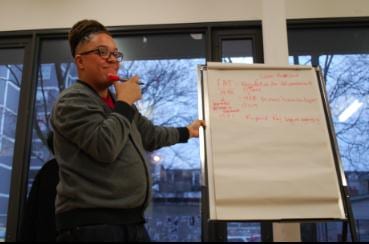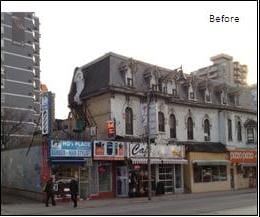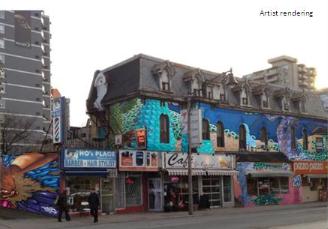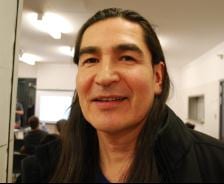
Church Street mural project co-curator Syrus Marcus Ware writes down ideas for the upcoming public art project. Credit: Andrea Houston

A building on the east side of Church Street, north of Wellesley. Credit: Andrea Houston

An artist's rendering of how a mural might look. Credit: Andrea Houston
After wrapping up an evening of stories about some of the earliest moments in Toronto’s gay rights movement, 25 artists have begun to visualize and sketch potential murals that may soon adorn buildings up and down Church Street.
Pioneers in the city’s gay rights movement were among more than 30 people at the Church Street Mural Project’s first community meeting, held March 11 at the 519 Church Street Community Centre.
The artists will bring back their ideas and sketches March 18 for the second meeting. Project curators James Fowler and Syrus Marcus Ware say work will begin May 6 and wrap up by October, in order to be on display for WorldPride in 2014.
For many, the 1981 bathhouse raids marked a pivotal point in Canada’s gay liberation movement and were a key moment that must be included in the mural project.
“I think the bathhouse raids was the most significant moment in our history. It started everything,” said Bruce Jones.
Billy Merasty recalled the protests that followed the bathhouse raids, when hundreds of people took to the streets and marched outside Queen’s Park. “I was actually in the crowd shaking the door of the Ontario legislature when we surged the crowd forward,” he says.
Chanelle Gallant remembered the anger she felt after the Pussy Palace raids in 2000 and the sense of resistance when dykes and allies held a kiss-in in front of the cameras at Toronto Police Services’ 52 Division.
Susan Gapka inserted more recent history: “In 2008 we finally got funding for sex reassignment surgery. Then the first trans march in 2009.”
Jones remembered another watershed moment: the first gay picnic, in 1972 at Hanlan’s Point.
Mosaic artist Anna Camilleri was one of 25 artists selected for the shortlist out of 69 applicants. She listened intently during the group’s rapid-fire brainstorming through 40 years of history. “Take me back to that picnic. Were there burgers? Did tables have gingham tablecloths? What did people talk about?” she asked.
The initial idea for the mural project came from Ward 27 Councillor Kristyn Wong-Tam, who proposed it to the Church Wellesley Village Business Improvement Area (BIA) in December.
“This will be one of the largest and most exciting outdoor art projects in the world,” Wong-Tam says, noting that the murals won’t be a chronological retelling of history. “We are looking for visual representations of moments and memories and historically significant events. It should not be a literal translation of a story.”
Amy Gottlieb says the murals should depict the full queer experience and include sex workers, trans people, queer refugees and international queer solidarity. “It’s important for me that this history is documented, even more than it already is . . . History can disappear.”
Wong-Tam says the group has already secured eight to 10 walls for murals along Church Street between Charles and Carlton streets.
“The curators will be working with the property owners to ensure the concepts are what they are comfortable putting on their walls,” she says. “So every step of the way, there is a checkpoint to make sure people feel good about what they’re doing.”
Once the proposed sketches are submitted March 18, Ware says, a selection committee will make a final decision about where to paint each mural. From there, the list of artists will be reduced to 10 or 12.
Ware says all participating artists will be paid for their work.
The group is not sure whether the murals will remain after WorldPride. Wong-Tam says it will depend on each business owner.
“We want to create a legacy,” she says. “How do we take the energy of the LGBT community and transform it into something more than hosting a party?”
Fowler says community members can still get involved and join the conversation through the Facebook page and on Twitter.

 Why you can trust Xtra
Why you can trust Xtra


